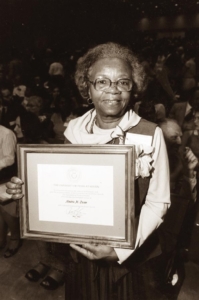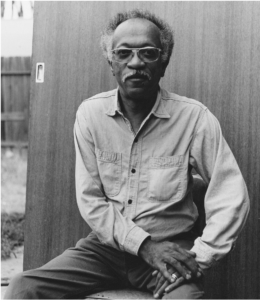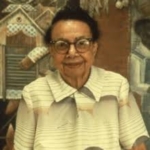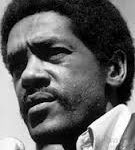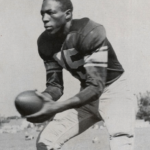‘Overcoming’: Documentary tells an important Texas tale
Image: Collage honoring Almetris Duren Hall inside the dormitory at the University of Texas. (Still image of footage shot by Ben Idom)
(Texarkana Gazette) Known as Mama D or Mama Duren to students whose lives she touched and shaped, Almetris Marsh Duren helped young scholars navigate college when the University of Texas at Austin integrated in the 1950s.
Duren became a pivotal figure in campus life, so much so her papers are stored at the university’s Briscoe Center for American History, a residence hall and endowed scholarship were named in her honor and she received awards for her undying commitment to service.
In 1956, UT first admitted black undergraduate students, and it fell to Duren to become the dormitory housemother for black women who joined UT but were relegated to housing far from the central campus. She later worked for the Dean of Students Office until her 1981 retirement.
For such African-American students joining UT, Duren was their lifeline: a mentor, helper and guide.
Mama D is also the subject of a new documentary film being completed. Titled “Still Overcoming,” the movie is self-described as “a documentary about race, education and gentrification in Austin, Texas,” according to its online promotional material. (more)
View movie trailer here.
Preserving Negro League History Has Never Been Easier, or Harder, Depending on Who You Ask
While digitization of old newspapers has led to a statistical renaissance in baseball archives, the stories of those who played the game are being lost
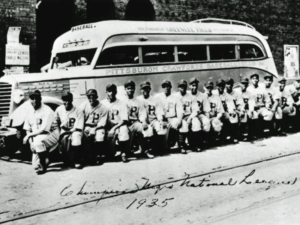
The Pittsburgh Crawfords, 1935 Negro National League Champions, are considered by many to be the greatest African American league team ever fielded. The team included five future Hall of Famers, from left: Oscar Charleston, first; Judy Johnson, fifth; Cool Papa Bell, 12th; Josh Gibson, 15th; and Satchel Paige, 17th. (AP Photo/HO)
(Smithsonian.com) Founded in a Kansas City, Missouri, YMCA in 1920, the National Negro League was where African-American ballplayers thrived. Kept out of the segregated Major Leagues, some of the best athletes of their generation, regardless of race, competed on teams like the Kansas City Monarchs, the Newark Eagles and the Homestead Greys.
The connective tissue between today’s Boston Red Sox and the city’s Negro League teams, like the Colored Tigers and the Royal Giants, is hard to comprehend because so much of that history vanished like a ball crushed over the Green Monster. Hardball historians, however, are out there keeping the Negro Leagues alive.
A writerly group of diehard baseball fans who contribute to the Seamheads Negro League Database have taken on the challenge of digging to find the numbers for legends like Josh Gibson and Satchel Paige, as well as the countless unsung players who were discriminated against by Major League Baseball and the sporting press. The digitization of newspaper archives has opened up research avenues for historians–especially those with a statistical bent–diving into the bigger scope of Negro Leagues, which includes barnstorming squads, local leagues, seasons in the Caribbean and Latin America, and even stories going back to baseball’s 19th-century roots.
“The internet has democratized the whole notion of research in the sense that anyone can get access to daily records of what took place, it’s no longer microfilm or dusty bound copies in basements somewhere,” says Gary Ashwill, a historian, editor, and writer for Seamheads. “Baseball, more than other major team sports, lends itself to digging because you can basically get a full game account from a box score.” (more)
MoMA Is Finally Giving Legendary Black Artist Charles White His Due
White was one of the first artists to depict black life in fine art. Nearly 40 years after his death, he’s finally getting the acclaim he deserves.
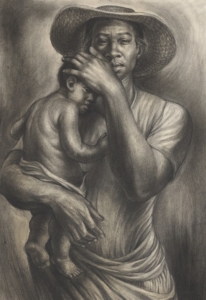
Charles White’s, ‘Ye Shall Inherit the Earth.’ 1953. Charcoal on paper. Private Collection. © The Charles White Archives/ Courtesy Princeton University Art Museum
(vice.com) Not a lot of black people know who Charles White is—which is equal parts heartbreaking and confusing, because it’s hard to overstate his importance as a black artist. White was one of the most successful and influential creatives to come out of the New Negro Movement. His striking, powerful renderings of seminal black figures (including Frederick Douglass, Mahalia Jackson, and Harry Belafonte) were featured on federally funded murals, national calendars, and even Hollywood film sets. He taught Kerry James Marshall. And yet, soon after his premature death in 1979, the art world (and, as a consequence, the black consciousness) largely forgot about him. But isn’t that often the case with black artists?
The Museum of Modern Art’s (MoMA) new retrospective on White—the first major museum exhibition dedicated to him in over 30 years—feels like a necessary revisionist history lesson, an attempt to undo erasure of the artist’s legacy. Walking through the exhibition, it’s astonishing how White’s drawings still deftly capture the black experience. He made figurative drawing a centerpiece of his craft, part of a personal mission to insert black bodies into the westernized canon of art. White put our innate beauty front and center, painting us in a divine, blemish-free light. At the time, the effort was novel and under-explored. Today, it’s on the tip of everyone’s tongue. Black bodies, and representation of them, have become the chief preoccupation of artists like Kehinde Wiley, Toyin Ojih Odutola, and Deana Lawson. The problems of yesterday are the problems of today. (more)
TIPHC Bookshelf
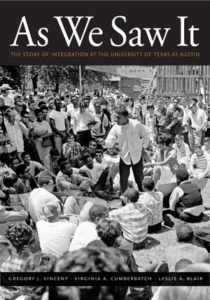 Published scholarship on black history in Texas is growing and we’d like to share with you some suggested readings, both current and past, from some of the preeminent history scholars in Texas and beyond. We invite you to take a look at our bookshelf page – including a featured selection – and check back as the list grows. A different selection will be featured each week. We welcome suggestions and reviews. This week, we offer, “As We Saw It, The Story of Integration at the University of Texas at Austin,” edited by Gregory J. Vincent, Virginia A. Cumberbatch, and Leslie A. Blair.
Published scholarship on black history in Texas is growing and we’d like to share with you some suggested readings, both current and past, from some of the preeminent history scholars in Texas and beyond. We invite you to take a look at our bookshelf page – including a featured selection – and check back as the list grows. A different selection will be featured each week. We welcome suggestions and reviews. This week, we offer, “As We Saw It, The Story of Integration at the University of Texas at Austin,” edited by Gregory J. Vincent, Virginia A. Cumberbatch, and Leslie A. Blair.
In 2016, the University of Texas at Austin celebrated two important milestones: the thirtieth anniversary of the Heman Sweatt Symposium on Civil Rights and the sixtieth anniversary of the first black undergraduate students to enter the university. These historic moments aren’t just special; they are relevant to current conversations and experiences on college campuses across the country. The story of integration at UT against the backdrop of the Jim Crow South is complex and momentous—a story that necessitates understanding and sharing. Likewise, this narrative is inextricably linked to current conversations about students’ negotiations of identity and place in higher education.
This Week in Texas Black History
Oct 22
Christia Daniels Adair, suffragist and civil rights activist, was born on this day in 1893, in Victoria, Texas. A graduate of Prairie View Normal College, Adair was an elementary school teacher in Kingsville where she organized a group of black and white women to acquire voting rights in 1919. She later became one of the first black women to vote in the state’s previously all-white primary. Adair and her husband relocated to Houston where she would become executive secretary for the Houston chapter of the National Association for the Advancement of Colored People. With the NAACP she led campaigns to desegregate the city’s public schools, libraries, transportation, hospitals and other public facilities. In 1952, Adair help found the first Harris County interracial political group, the Harris County Democrats. In 1977, a Houston city park was named for her.
Oct 22
In 1936, Bobby Seale was born on this day in Dallas. Seale would become a political activist and revolutionist, and in 1966 co-founded (with Huey Newton) and was national chairman of the Black Panther Party. J. Edgar Hoover, Federal Bureau of Investigation director, described the Panthers as “the greatest threat to the internal security of the country. “Seale was also one of the “Chicago Eight” defendants charged with conspiring to incite riots at the 1968 Democratic Party Convention. Seale was charged with 16 counts of contempt of court after repeated outbursts during the trial for which he was bound and gagged. He spent four years in prison. In 1973, he finished second in a run for mayor of Oakland, Ca. Since, Seale has been a community activist and author. Among his several books are his biography, “Seize the Time,” and a cook book, “Barbeque’n with Bobby.”
Oct 23
On this day in 1955, Dallas native Charlie “Choo-Choo” Brackins played the final minutes of a game against the Cleveland Browns, making him the fourth black quarterback to play in an NFL game, but the first quarterback from a historically black college to play in the league. Brackins attended Lincoln High School in Dallas then starred at Prairie View A&M, leading the Panthers to 33 wins in the 37 games he played. He was a 16th round pick by the Green Bay Packers in the 1955 draft.
Oct 24
Two historically black Austin institutions of higher education, Samuel Huston College and Tillotson College, merged to form Huston-Tillotson College (now University) on this day in 1952. Tillotson Collegiate and Normal Institute (named after Unitarian minister George Jeffrey Tillotson) first opened its doors in 1881, and Samuel Huston College in 1876 in Dallas, relocating to Austin two years later. The two East Austin schools were less than a mile apart. Huston-Tillotson is a coeducational college of liberal arts and sciences, operated jointly under the auspices of the American Missionary Association of the United Church of Christ and the Board of Education of the United Methodist Church.
Oct 25
Prairie View and National Basketball Association great Zelmo Beaty was born on this day in 1939 in Hillister (50 miles north of Beaumont). Beaty played during segregation at all-black Scott High School in nearby Woodville. At PV, Beaty led the Panthers to the 1962 NAIA national championship and was named tournament MVP. He averaged 25 points and 20 rebounds during his collegiate career. Though undersized at 6-9 for a center, Beaty was the third overall pick in the 1962 NBA draft by the St. Louis Hawks (now Atlanta), made the 1962-63 NBA All-Rookie Team and was a league All-Star in 1966 and 1968 in an era dominated by centers Wilt Chamberlain and Bill Russell. Beaty jumped to the American Basketball Association and led the Utah Stars to their only championship in 1971. In eight NBA seasons, he averaged 16 points and 11 rebounds a game. He is a member of the National Collegiate Basketball Hall of Fame.
Oct 25
On this day in 2002, Dallas Cowboys’ running back Emmitt Smith passed Chicago Bears great Walter Payton and became the National Football League’s all-time rushing leader on an 11-yard gain in the fourth quarter of the Cowboys’ 17-14 loss to the Seattle Seahawks in Dallas. Smith retired two years later with 18,355 career yards to Payton’s 16,726. Smith, who played collegiately at the University of Florida, was the Cowboys first round pick (number 17 overall) in the NFL’s 1990 draft. He played in eight Pro Bowls and was a four-time first-team All-Pro. In 2005, Smith was inducted to the Cowboys’ Ring of Honor and in 2010 he was enshrined in the Pro Football Hall of Fame.
Blog: Ron Goodwin, Ph.D., author, PVAMU history professor
Ron Goodwin is an assistant professor of history at Prairie View A&M University. Even though he was a military “brat,” he still considers San Antonio home. Like his father and brother, Ron joined the U.S. Air Force and while enlisted received his undergraduate degree from Texas Lutheran University in Seguin, Texas. After his honorable discharge, he completed graduate degrees from Texas Southern University. Goodwin’s book, Blacks in Houston, is a pictorial history of Houston’s black community. His most recent book, Remembering the Days of Sorrow, examines the institution of slavery in Texas from the perspective of the New Deal’s Slave Narratives.
Recent Posts
The team
We live in an amazing world. There’s little chance my great grandfather, Big Pappa, could have ever envisioned world-wide communications at the click of a mouse. I’d like to say Big Pappa was a simple man. A country preacher from Gonzales, Texas. But he was so much more. He always told me that my brains…(more)
History and Honesty
Recently I was asked to review a new history textbook. While the prose was pretty good and the facts were basically the facts, the information surrounding the presidency of Barack Obama gave me pause. History will forever remember the initial response of the Republican brain trust immediately after Obama was acknowledged as the 44th president. (more)
Submissions wanted
Historians, scholars, students, lend us your…writings. Help us produce the most comprehensive documentation ever undertaken for the African American experience in Texas. We encourage you to contribute items about people, places, events, issues, politics/legislation, sports, entertainment, religion, etc., as general entries or essays. Our documentation is wide-ranging and diverse, and you may research and write about the subject of your interest or, to start, please consult our list of suggested biographical entries and see submission guidelines. However, all topics must be approved by TIPHC editors before beginning your research/writing.
We welcome your questions or comments. Please contact Michael Hurd, Director of TIPHC, at mdhurd@pvamu.edu.
Click edit button to change this text.

